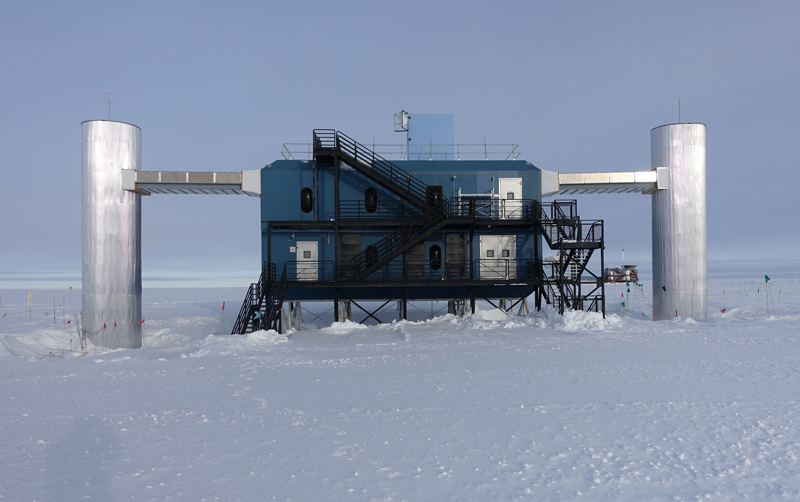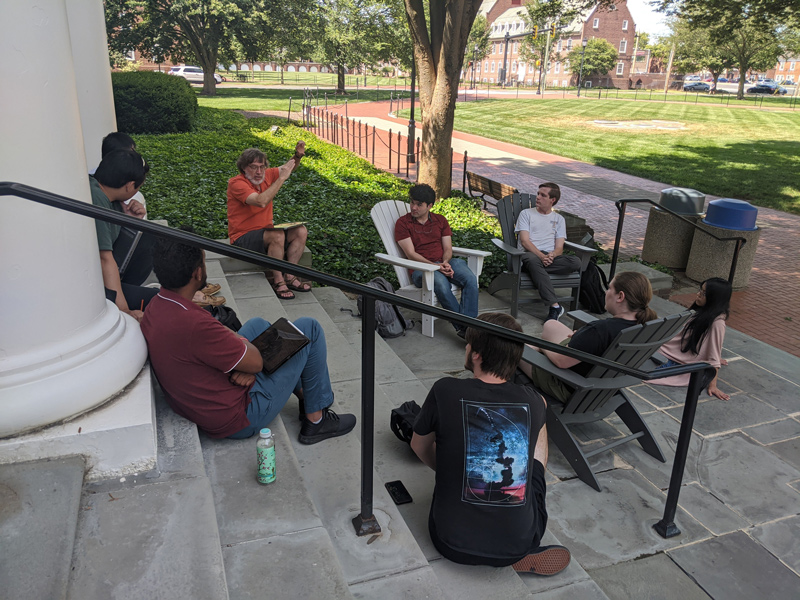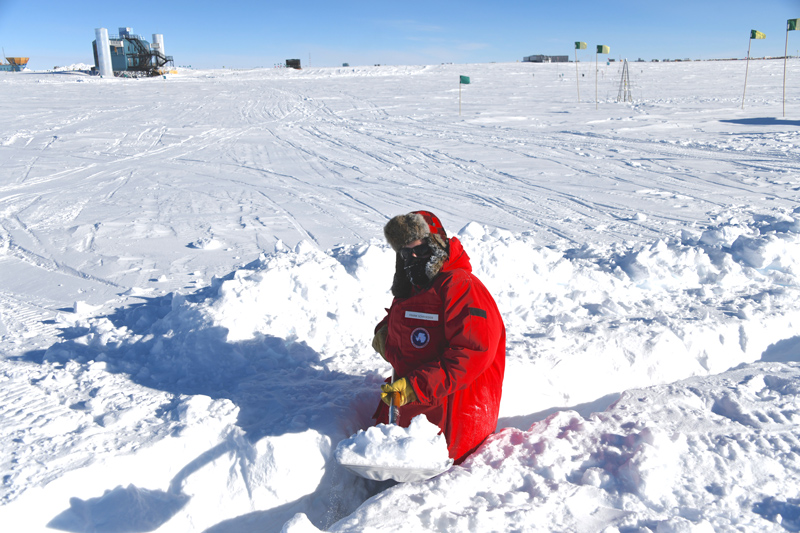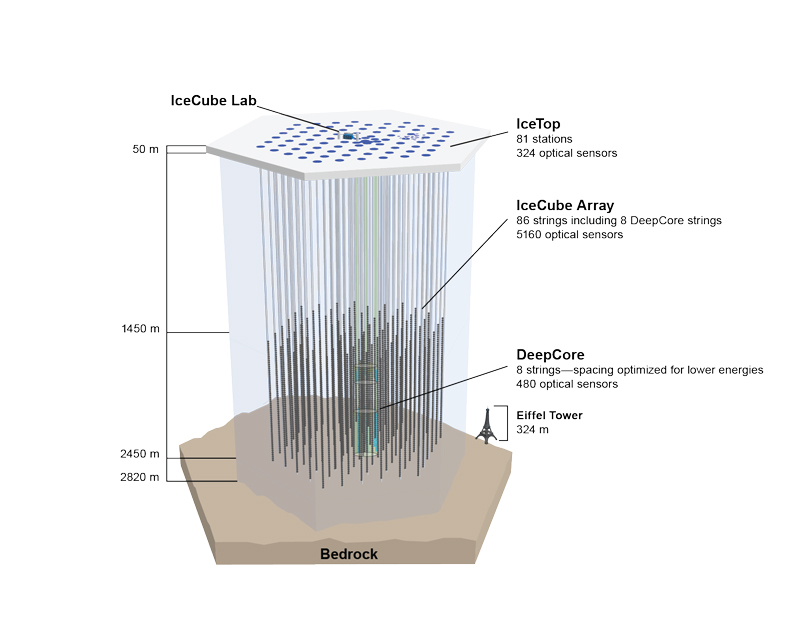


Data from the cosmos
Photos courtesy of Frank Schroeder, Alan Coleman and the IceCube Collaboration August 24, 2021
Massive Antarctic telescope provides students with findings for analysis
Buried more than a mile deep in the clear ice of Antarctica, the world’s largest observatory of its kind is collecting data about neutrinos, high-energy subatomic particles that speed through space, that helps scientists explore the cosmos and seek to answer some of the fundamental questions in physics.
Known as IceCube, the observatory at the South Pole has been in full operation since 2011, detecting hundreds of neutrinos from space and producing numerous important findings in particle astrophysics. It’s made up of a collaboration of about 300 physicists from 53 institutions, including the University of Delaware, in 12 countries.
This summer, the data gathered by the massive telescope also provided a group of 16 undergraduate and graduate students from UD and five other institutions with the opportunity to contribute to the research. The students, most on the UD campus and a few working remotely, used supercomputers to analyze data from IceCube as they developed their own research and computer skills.
The program was supported through a National Science Foundation (NSF) grant awarded in 2020, part of plans to improve big-data infrastructure in order to continue and expand the management and analysis of IceCube data. The $6 million, four-year grant focused on six states, including Delaware, targeted by EPSCoR (Established Program to Stimulate Competitive Research), an NSF grant program to help states develop their research capabilities and institutions.
“This summer program involved students from institutions in the six states, all selected based on merit,” said Frank G. Schroeder, assistant professor of physics and astronomy at UD and a Sloan Research Fellow, who is a co-principal investigator on the NSF grant. The program will move among the other EPSCoR universities in the future after its initial session at UD.

Participating students this summer began the program with a series of lectures in which Schroeder and other professors and postdoctoral researchers reviewed the skills and techniques needed for data analysis. Each student then began a research project involving IceCube data under the direction of the researchers with the project, including Schroeder, postdoctoral researcher Alan Coleman and Prof. David Seckel, all from the Bartol Research Institute at UD’s Department of Physics and Astronomy.
To conduct their research, the students used supercomputing resources from the University of Wisconsin, Madison, the lead university in the IceCube collaboration, to analyze the data or to run simulations. They also gained experience in presenting their findings, through group sessions held twice a week.
“They all worked on projects directly related to IceCube or tangential to it,” Coleman said. “Some measured particles coming into our galaxy, such as cosmic rays or neutrinos. Those are the kinds of data that IceCube is collecting.”
As the students continue working at their home institutions this fall, they will be applying what they learned about data science, Schroeder said. The expectation is that their new knowledge and skills will benefit them and their future research, which may or may not involve the IceCube project.
“We hope that some of these students will get interested in this subfield and continue to work in it,” Schroeder said. “But they had to learn very technical computing skills, the kinds of skills that are used in a lot of areas of research in physics, so what they learned this summer will be useful to them even if they never work on IceCube again.”

For Dana Kullgren, a sophomore in UD's Honors College who is looking ahead to graduate school and a career in academia, the program offered a perfect opportunity to begin exploring research and to develop her computer and analytical skills. At first, she said, she was worried about her lack of research experience.
“However, I found that everyone was willing to explain things to me when I didn’t understand them, so now I feel much more confident about my research project,” she said. “I learned new things by doing and by asking questions. This program gave me my first experience with research, and I couldn’t have asked for a better one.”
Another participant, Diana Leon Silverio, is a physics graduate student at the South Dakota School of Mines and Technology who was already conducting research involving IceCube. But the summer program greatly expanded her skills and her interest, she said.
“It also allowed me to meet many scientists and the role they play within the collaboration [as well as] many contemporary students who, like me, are working on Ice Cube,” Silverio said. “I really want to continue growing and learning academically around IceCube—and maybe, in the not too distant future, to contribute to this wonderful experiment.”
More about IceCube and EPSCoR
The IceCube Neutrino Observatory has been operating at NSF’s Amundsen-Scott South Pole Station for more than a decade, briefly catching neutrinos as they travel through space at almost the speed of light and pass through almost anything they encounter.
The data from IceCube’s 5,000-plus optical sensors—suspended on 86 cables, like beads on a string, deep in the Antarctic glacier—has allowed new research into violent events such as colliding black holes and exploding stars. Now, the scientists who collaborate on the observatory are working on an upgrade.
In 2019, the NSF awarded a grant to the IceCube Collaboration to begin upgrading the capacity of the observatory.
Planning for the next step, a large-scale extension called IceCube-Gen2, is underway now. UD is playing a lead role regarding a surface detector for cosmic rays that will complement the extension of detectors deep in the ice. Construction of the additional detectors is proposed to start in 2024, with installation at the Pole beginning two or three years later and lasting several years, giving physicists access to its data far into the future.
“This is a project that will go on to be worked on by the next generation of scientists,” Schroeder said.

The student research program at UD this summer was designed to train some of that next generation. It was part of a larger grant supporting the improvement of infrastructure in the EPSCoR states of Alabama, Alaska, Delaware, Kansas, Nebraska and South Dakota.
While UD is not the lead institution, it receives the largest share of the $6 million, about $1.8 million, and Seckel serves as chair of the collaborative grant’s executive committee. The grant supports early career faculty, trains postdoctoral scholars and college students and exposes high school students from underrepresented groups to IceCube, big data and STEM fields in general.
“The success of this project will establish a diverse, competitive and sustainable EPSCoR team with increased research capacity to ensure that EPSCoR leverages a prominent role in IceCube’s future,” according to the grant proposal.
To learn more about EPSCoR at UD, visit Delaware EPSCoR.
Contact Us
Have a UDaily story idea?
Contact us at ocm@udel.edu
Members of the press
Contact us at 302-831-NEWS or visit the Media Relations website

